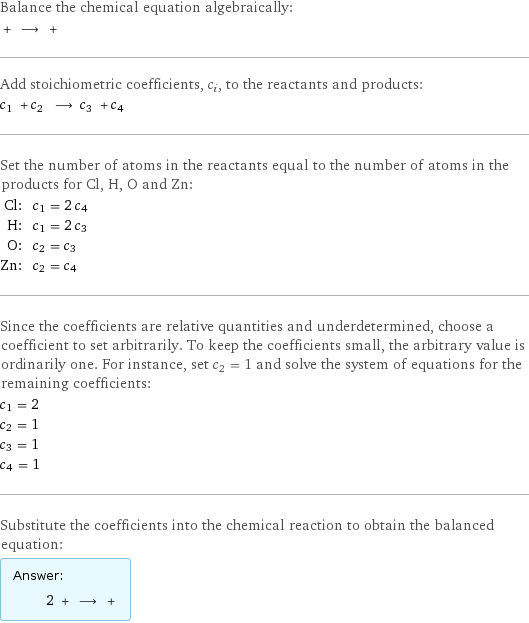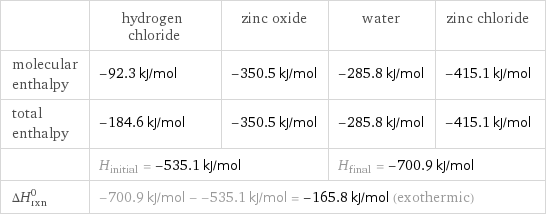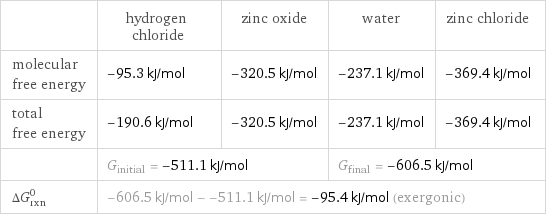Input interpretation

hydrogen chloride + zinc oxide ⟶ water + zinc chloride
Balanced equation

Balance the chemical equation algebraically: + ⟶ + Add stoichiometric coefficients, c_i, to the reactants and products: c_1 + c_2 ⟶ c_3 + c_4 Set the number of atoms in the reactants equal to the number of atoms in the products for Cl, H, O and Zn: Cl: | c_1 = 2 c_4 H: | c_1 = 2 c_3 O: | c_2 = c_3 Zn: | c_2 = c_4 Since the coefficients are relative quantities and underdetermined, choose a coefficient to set arbitrarily. To keep the coefficients small, the arbitrary value is ordinarily one. For instance, set c_2 = 1 and solve the system of equations for the remaining coefficients: c_1 = 2 c_2 = 1 c_3 = 1 c_4 = 1 Substitute the coefficients into the chemical reaction to obtain the balanced equation: Answer: | | 2 + ⟶ +
Structures

+ ⟶ +
Names

hydrogen chloride + zinc oxide ⟶ water + zinc chloride
Reaction thermodynamics
Enthalpy

| hydrogen chloride | zinc oxide | water | zinc chloride molecular enthalpy | -92.3 kJ/mol | -350.5 kJ/mol | -285.8 kJ/mol | -415.1 kJ/mol total enthalpy | -184.6 kJ/mol | -350.5 kJ/mol | -285.8 kJ/mol | -415.1 kJ/mol | H_initial = -535.1 kJ/mol | | H_final = -700.9 kJ/mol | ΔH_rxn^0 | -700.9 kJ/mol - -535.1 kJ/mol = -165.8 kJ/mol (exothermic) | | |
Gibbs free energy

| hydrogen chloride | zinc oxide | water | zinc chloride molecular free energy | -95.3 kJ/mol | -320.5 kJ/mol | -237.1 kJ/mol | -369.4 kJ/mol total free energy | -190.6 kJ/mol | -320.5 kJ/mol | -237.1 kJ/mol | -369.4 kJ/mol | G_initial = -511.1 kJ/mol | | G_final = -606.5 kJ/mol | ΔG_rxn^0 | -606.5 kJ/mol - -511.1 kJ/mol = -95.4 kJ/mol (exergonic) | | |
Chemical names and formulas

| hydrogen chloride | zinc oxide | water | zinc chloride Hill formula | ClH | OZn | H_2O | Cl_2Zn name | hydrogen chloride | zinc oxide | water | zinc chloride IUPAC name | hydrogen chloride | oxozinc | water | zinc dichloride